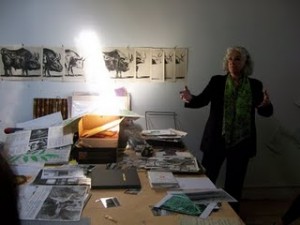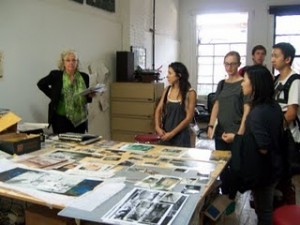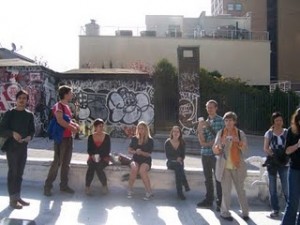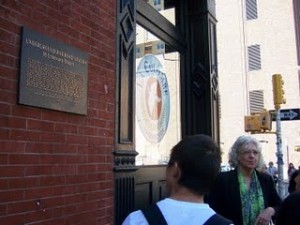It’s surreal to meet artists who were contemporaries and friends of Gordon Matta-Clark, namely Andrea Collard. Mary  Woods took us to meet Andrea on the steps leading up to her studio. Our stamina was immediately put to the test as she invited us to climb the six extra-tall stories to the rooftop. From this vantage point she described how the neighborhood of Tribeca had changed over the years—from open lots to densely packed buildings, from solid brick walls to windows being punched out, from blank surfaces to graffiti-covered walls, from un-manicured rooftops to penthouses and roof-gardens.
Woods took us to meet Andrea on the steps leading up to her studio. Our stamina was immediately put to the test as she invited us to climb the six extra-tall stories to the rooftop. From this vantage point she described how the neighborhood of Tribeca had changed over the years—from open lots to densely packed buildings, from solid brick walls to windows being punched out, from blank surfaces to graffiti-covered walls, from un-manicured rooftops to penthouses and roof-gardens.
Andrea pointed out the depressions in the flat roof that were remnants of skylights she had cut into the roof and through the ceiling of her studio space below. She wanted to let light in, and back in those days you could just take a chainsaw to a roof and add skylights. She has since had professionals come and cover the original holes and replaced them with proper skylights that wouldn’t allow water to leak all over her studio and artwork.
Back downstairs in Andrea’s studio she began to show us some of her projects and photos from the 1970s. She kept  emphasizing that during that time in NYC, there was only “space and money,” and she and her associates took full advantage of this. There was no tone of arrogance in her voice as she casually mentioned that she was part of the group who put together the Times Square show, which was a collection of artists showing their work in buildings along Times Square in the ‘70s.
emphasizing that during that time in NYC, there was only “space and money,” and she and her associates took full advantage of this. There was no tone of arrogance in her voice as she casually mentioned that she was part of the group who put together the Times Square show, which was a collection of artists showing their work in buildings along Times Square in the ‘70s.
The work Andrea showed us in her studio generally dealt with idea of nature creeping into the city, through plants, birds, and the like. Also, the shear volume of photographs (negatives, contact sheets, and prints) was mind-boggling. It shows just how much one accumulates over the course of a lifetime—especially artists—always looking, always recording, always documenting.
The task she is now undertaking with help from some assistants is to create a digital catalogue of her life’s work, to make it readily available and to have all of her work organized and collected together, unlike how it is currently scattered around the studio, or in storage, or other miscellaneous locations.
The next leg of the visit with Andrea Collard was a quick walking tour of the Tribeca area where she has lived since  first arriving in NYC in the ‘70s. Tribeca was also the hangout of Gordon Matta-Clark and other artists, as it was pretty desolate and aching to be enhanced by artistic interventions. As we walked the streets of Tribeca, Andrea pointed out several cast iron buildings that were left over from the industrial past of the city, which were also the predominant buildings standing during the ‘70s in that area. From her photographs that she took 30+ years ago we were able to compare the barren land of the ‘70s to the heavily built up Tribeca that exists today. One place in particular that we stopped in front of was a plaque that read “Underground Railroad Station, 36 Lispenard
first arriving in NYC in the ‘70s. Tribeca was also the hangout of Gordon Matta-Clark and other artists, as it was pretty desolate and aching to be enhanced by artistic interventions. As we walked the streets of Tribeca, Andrea pointed out several cast iron buildings that were left over from the industrial past of the city, which were also the predominant buildings standing during the ‘70s in that area. From her photographs that she took 30+ years ago we were able to compare the barren land of the ‘70s to the heavily built up Tribeca that exists today. One place in particular that we stopped in front of was a plaque that read “Underground Railroad Station, 36 Lispenard  Street” adding yet another layer of history to the already rich background of the area.
Street” adding yet another layer of history to the already rich background of the area.
Finally, at the gate of Hudson Square Park, Andrea spoke of recording sounds of the city, and how the sonic-scape has drastically changed over the course of her almost 40 years in the city, and she is constantly “looking for a sonically sweeter space.”



